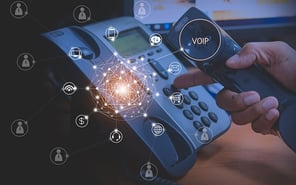Unified Communications Services for Businesses
What is Unified Communications?
Organizations are getting smarter and more efficient with how they help their employees, end users, and customers. Unified communications (UC) is the all-encompassing term for phone systems that do more than just voice calls. They can communicate via SMS text messaging, chat with teams, make video calls and manage calendars, all in one app.
By consolidating these tools into one app, UC simplifies communication and enhances productivity, making it an invaluable asset for modern businesses.
Bring Your Workforce Together with a Unified Communication System
Collaborate from Anywhere
Collaborate from anywhere on any device via voice, video, and instant messaging. All of your desktop apps are also available on your phone in one simple app.
Secure Cloud &
On-Premise Hosting
No matter where you choose to host your phone system, be it on-site or in the cloud with UCaaS, we'll work with you to find the best Unified Communications solution for your business.
No Calls Go Unanswered
In-depth reporting and analytics can help make sure calls are getting answered and returned in a timely manner. Track activity and efficiency with historical and real-time data.
Upgrade Your Call Center to a Contact Center
Increase the efficiency of your contact center by going beyond just phone conversations and giving your agents the ability to talk via email, chat, SMS texting, and phone with a unified communications system. Advanced reporting and analytics give insight into in your communication and collaboration tools, as well as the activity of your call center and individual teams.
Simplify Your Communication with UC
If managing a phone system isn’t for you, Unified Communications as a Service (UCaaS) is the ideal solution. With UCaaS, there’s no need to worry about maintenance or management. Simply pay a monthly fee, and enjoy a seamless, hassle-free communication experience.
Discover the Power of Unified Communications: Key Features
Unified communications services revolutionize how organizations support their employees, end users, and customers by integrating multiple communication tools into a single, cohesive platform. UC encompasses a wide range of features designed to enhance productivity and streamline communication.
Communication Tools
![]()
Voice Calls
Voice communication has been essential for over a century, but many now prefer text or video. A versatile phone system supporting SMS, social media, and instant messaging is crucial.
Despite the shift, voice remains key in unified communications.
![]()
Instant Messaging
Instant messaging enhances internal communications by providing quick responses, even when coworkers are unavailable.
Using instant messaging within a Unified Communications (UC) system is more efficient than switching devices or apps. UC integrates all communication tools into one app, streamlining conversations and improving productivity.
![]()
Mobility
With a single, efficient app, you can access all your desktop applications on your tablet and phone. This app ensures full functionality on mobile devices, delivering high performance whether you’re at home, in a hotel, or on the go. Simply log in with your credentials to access everything you need.
![]()
Fax
Fax, a long-standing communication method, is now integrated into the Unified Communications (UC) platform. This eliminates the need for bulky, expensive fax machines, as all necessary features are available within your UC system.
Collaboration Tools
Team Messaging/Group Messaging
Enhance collaboration by communicating with entire teams without meetings or calls. Streamline problem-solving, reduce email threads, and consolidate conversations into a single feed. Share and store documents easily, providing instant feedback and access to important files.
Calendar Integration
Seamlessly integrate with your calendar, allowing you to manage your day within a single app. View your schedule, join meetings, and handle tasks without switching between different calendars or applications.
Presence
Presence features show coworkers’ availability, improving efficiency. For example, if Greg is on the phone, you can message him instead of calling or visiting his office, saving time.
On-premise systems offer the best presence features, while cloud systems may have less complete information due to third-party devices.


Audio Conferencing
Easily connect three or more people on a voice call with a simple web link, synced with your calendar.
Web Conferencing
Build on audio conferencing by sharing screens for presentations and collaborative control, ensuring clarity and alignment.
Video Conferencing
Enhance collaboration further with video, allowing participants to see each other, improving engagement and understanding.
Reporting and Analytics
Advanced Reporting and Analytics
Gain insights into your communication patterns and performance with advanced reporting and analytics tools. These features help you make data-driven decisions to improve efficiency and productivity.
Call Recording
Record calls for training, quality assurance, and compliance purposes. Easily access and review recorded calls within your Unified Communications system.
Customer Experience and Engagement
Interactive Video Response
Engage customers with interactive video responses, providing a more personalized and dynamic communication experience.
Call Center/Contact Center
Optimize customer service with a fully integrated call center/contact center solution. Manage customer interactions efficiently and improve response times.
Phone System Security
Concerns about phone system security are common today. However, UC systems offer robust protection. Traditional phone systems are vulnerable to hacking, leading to costly breaches, whereas UC systems are highly secure.
They feature end-to-end encryption and comply with the Federal Information Security Management Act (FISMA), covering requirements for PCI, HIPAA, Gramm-Leach-Bliley, and other security standards.

Embrace the Future with Unified Communications
In today’s fast-paced business environment, staying connected and secure is crucial. Unified Communications offers a comprehensive solution that enhances collaboration, streamlines operations, and ensures robust security for businesses of all sizes.
- Enhanced Collaboration: Improve teamwork and communication across your organization.
- Streamlined Operations: Simplify processes and increase efficiency.
- Scalability: Easily adapt and grow your communication system as your business expands.
Transform Your Business Today
Embrace the future of communication and experience the benefits of a seamless, efficient, and secure UC system. Fill out the form to get in touch with us today!

Schedule Your Free Consultation Today!
Explore More Insights

Being Told You Need a New Business Phone System? Read This First.
Originally Published August 2018 Updated November 2024 Upgrading doesn’t have to mean buying new. We’ve worked with ...
Four Signs You Need a New Unified Communications Partner
Switching Unified Communications partners is not a foreign concept. I see it happen all the time. But how do you know ...


